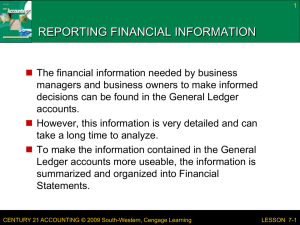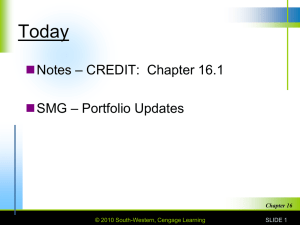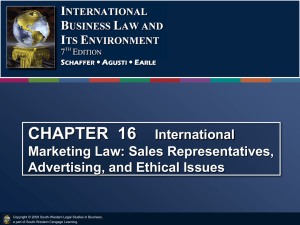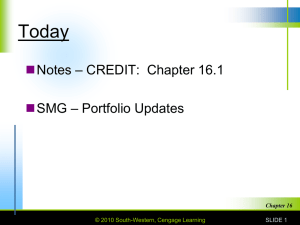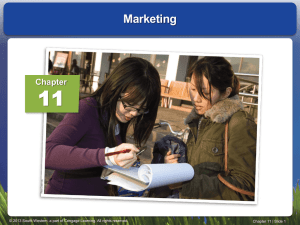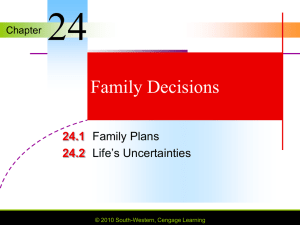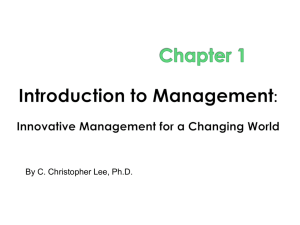Chapter 4 Adapting to Work
advertisement
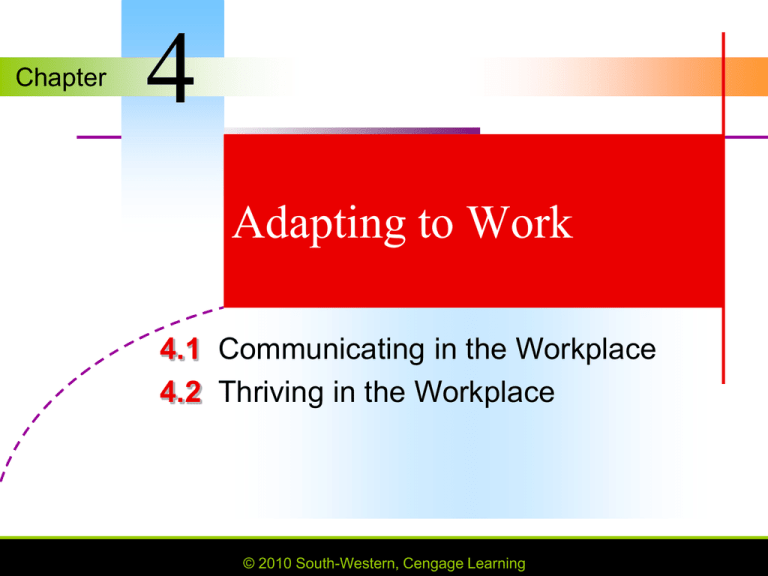
Chapter 4 Adapting to Work 4.1 Communicating in the Workplace 4.2 Thriving in the Workplace © 2010 South-Western, Cengage Learning Lesson 4.1 Communicating in the Workplace GOALS Describe effective communications on the job. Explain strategies for effective human relations at work. Chapter 4 © 2010 South-Western, Cengage Learning SLIDE 2 Effective Communication at Work Success on the job depends on good communication skills. Of all the job activities you perform in a day, 80 percent involve communication in one form or another. More than half of all job communication involves listening and speaking. Many job ads list good communication skills as a must. Chapter 4 © 2010 South-Western, Cengage Learning SLIDE 3 Communication on the Job 36% Listening 20% Speaking Writing 7% 24% Reading All Other Activities 13% Chapter 4 © 2010 South-Western, Cengage Learning SLIDE 4 Listening Hearing vs. listening Sympathetic listening Critical listening Creative listening Chapter 4 © 2010 South-Western, Cengage Learning SLIDE 5 Hearing vs. Listening Hearing is the process of perceiving sound. Listening is an active hearing process that requires concentration and effort. Chapter 4 © 2010 South-Western, Cengage Learning SLIDE 6 Sympathetic Listening Sympathetic listening is the ability to perceive another person’s point of view and to sense what the person is feeling. It is often called empathetic listening. Chapter 4 © 2010 South-Western, Cengage Learning SLIDE 7 Critical Listening Critical listening is the ability to differentiate facts from opinion. When analyzing information about a product or service you are considering purchasing, use critical listening. Chapter 4 © 2010 South-Western, Cengage Learning SLIDE 8 Creative Listening Creative listening means listening with an open mind to new ideas. Group problem-solving techniques, such as brainstorming, require creative listening. Chapter 4 © 2010 South-Western, Cengage Learning SLIDE 9 Informal Speaking Making contact with others Exchanging information Influencing others Solving problems Chapter 4 © 2010 South-Western, Cengage Learning SLIDE 10 Formal Speaking To inform To entertain To persuade Chapter 4 © 2010 South-Western, Cengage Learning SLIDE 11 Stage Fright Stage fright (nervousness) is a natural and common reaction. Tips for controlling stage fright: Build your confidence. Be well prepared. Practice public speaking. Chapter 4 © 2010 South-Western, Cengage Learning SLIDE 12 Communication Flow in the Workplace Horizontal communication Occurs among employees of equal rank Downward communication Flows from higher to lower levels in an organization Upward communication Flows from lower to higher levels in an organization Chapter 4 © 2010 South-Western, Cengage Learning SLIDE 13 E-mail Communication E-mail is the most common form of communication in business today. Rules of good writing apply. Be concise. Use correct grammar. Proofread. Review for clarity before sending. Chapter 4 © 2010 South-Western, Cengage Learning SLIDE 14 E-mail Communication Advantages Fast Inexpensive Simultaneous Easy to learn and use Disadvantages Overuse No cues from reaction Lack of privacy Temptation to use inappropriately Chapter 4 © 2010 South-Western, Cengage Learning SLIDE 15 Human Relations at Work Human relations is the art of getting along with others. To be truly competent in human relations, you need to have a good understanding of yourself and of others and a genuine concern for their needs and feelings. Chapter 4 © 2010 South-Western, Cengage Learning SLIDE 16 Improve Your Relationships Accept differences. Treat others as individuals. Empathize with others. Praise others. Focus on problems, not people. Accept responsibility. Avoid dogmatic statements. Treat others as equals. Trust others. Control your emotions. Chapter 4 © 2010 South-Western, Cengage Learning SLIDE 17 Lesson 4.2 Thriving in the Workplace GOALS Describe employer expectations related to work rules, work attitudes, and work attendance. Discuss two theories of motivation and the results of job satisfaction. Chapter 4 © 2010 South-Western, Cengage Learning SLIDE 18 Employer Expectations Employers expect employees to behave in ways that will help meet the goals of the business. To inform employees of expected behavior, employers create work rules and policies. Employees who thrive in the workplace exceed these expectations. Chapter 4 © 2010 South-Western, Cengage Learning SLIDE 19 Work Rules Work rules are the do’s and don’ts of fitting in successfully and having a positive work experience. Unwritten work rules Not documented Not verbally communicated Written work rules Posted Include in an employee manual Chapter 4 © 2010 South-Western, Cengage Learning SLIDE 20 Work Attitudes Employees’ work attitudes are important to employers because they affect morale, output (production), and public relations. A good attitude makes a favorable impression. Chapter 4 © 2010 South-Western, Cengage Learning SLIDE 21 Leave a Favorable Impression Remember customers’ names and preferences. Make an extra effort to be helpful. Demonstrate knowledge, enthusiasm, and interest in customers. Display genuine concern for the quality of products and services. Care about people and meeting their needs. Listen sympathetically to customer complaints. Take pride in yourself and your work. Chapter 4 © 2010 South-Western, Cengage Learning SLIDE 22 Absenteeism Absenteeism is the record and pattern of absence rates for workers. Businesses must deal with the causes and effects of absenteeism. Types of absentees Consequences of absenteeism Costs of absenteeism Chapter 4 © 2010 South-Western, Cengage Learning SLIDE 23 Motivation and Needs All human beings have some needs that are basic to survival and other needs that go beyond mere physical existence. Unfulfilled needs motivate people to work toward satisfying those needs. Chapter 4 © 2010 South-Western, Cengage Learning SLIDE 24 Maslow’s Hierarchy of Needs The model has five levels of need: Level 1: Food, Clothing, and Shelter Level 2: Safety and Security Level 3: Love and Belonging Level 4: Self-Esteem Self-esteem is self-respect and recognition from others. Level 5: Self-Actualization Self-actualization is the need to reach one’s full potential, to grow, and to be creative. Chapter 4 © 2010 South-Western, Cengage Learning SLIDE 25 (continued) Maslow’s Hierarchy of Needs Employment can help satisfy all five levels of needs. According to Maslow, in general, lowerlevel needs must be satisfied first. Once a need is met, the next higher one in the hierarchy begins to motivate the person’s behavior. Chapter 4 © 2010 South-Western, Cengage Learning SLIDE 26 Maslow’s Hierarchy of Needs Level 5 Self- actualization Level 4 Level 3 Level 2 Level 1 Self-esteem Love and Belonging Safety and Security Food, Clothing, and Shelter Chapter 4 © 2010 South-Western, Cengage Learning SLIDE 27 Herzberg’s Two-Factor Theory Hygiene factors Hygiene factors are job elements that dissatisfy when absent but do not add to satisfaction when present. They include pay, fringe benefits, workplace environment. Motivators Motivators are job elements that increase job satisfaction. They include challenging work, responsibility, recognition, achievement, and opportunities for personal growth. Chapter 4 © 2010 South-Western, Cengage Learning SLIDE 28 Results of Job Satisfaction Increased productivity Productivity is the relationship between the cost of paying for workers and the output that is received from their work. Self-esteem and self-actualization Rewards and opportunities Chapter 4 © 2010 South-Western, Cengage Learning SLIDE 29
